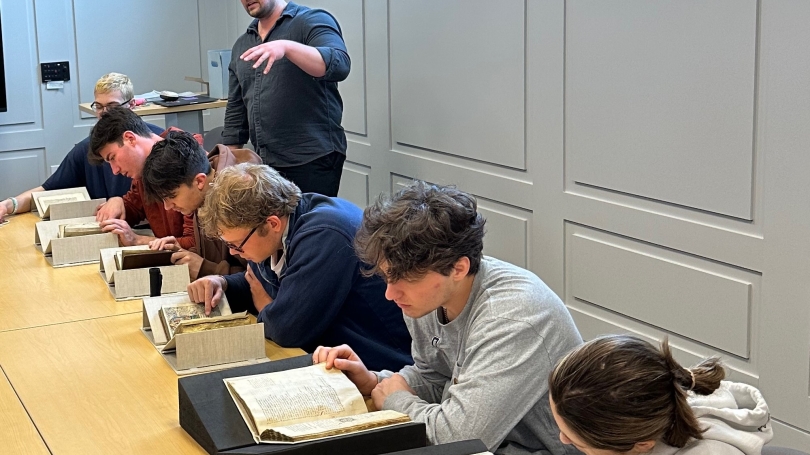
- Curriculum
- Foreign Study
- Projects & Awards
- Inclusivity
- News & Events
- People
- Our graduates
Back to Top Nav
Back to Top Nav
Back to Top Nav
Latin 10.04 Latin Manuscripts and Palaeography was a hands-on introduction to manuscript studies in which students learned to read the most important scripts that preserve Latin texts of all kinds in manuscripts written from the first century BC to the sixteenth century AD. With the help of many generous guest lecturers, we also learned that there is more to manuscript studies than palaeography, and more to a manuscript than the text it preserves: its decoration, the material support on which it is written, the way it is bound, and the way it was used and altered by its readers all preserve information about the past. We also toured the Conservation Lab with Deborah Howe, Collections Conservator at Dartmouth College Library, to learn how manuscripts are cared for once they reach the Dartmouth Collection.
With the help of the Rauner Special Collections librarians, we were able to work closely with manuscripts in the College collections, supplemented with digital images of manuscripts held in other libraries around the world; a guest lecture by Morgan Swan, Special Collections Librarian for Teaching & Scholarly Engagement at Rauner Special Collections Library, and Tim Baker, Senior Lecturer in Religion, introduced us to codicology, the study of the archaeology of the book as a material object.
With the help of a Humanities Lab course grant from the Leslie Center for the Humanities, we were able to continue our study of the technologies of the scribe and the bookbinder with hands-on experimentation in the Book Arts Workshop, led by Sarah Marcella Parella, Book Arts Workshop Program Manager. We made our own lamp black ink and imitated ancient literary papyri with reed pens on papyrus; we made iron gall ink, and used quill pens, made specially for us by Dennis Ruud, to imitate insular miniscule and Gothic manuscripts on parchment.
We also practiced sewing quires on bands using sewing frames to learn how medieval codices are constructed, and learned about decorated initials and miniatures during a visit from Beth Mattison, Andrew W. Mellon Curator of Academic Programming and Curator of European Art at the Hood Museum.
Our grant from the Leslie Center also made it possible to host Jesse Meyer of Pergamena Parchments, who demonstrated (and let us participate in) the process of turning a goat skin into parchment, and came to the Rauner Special Collections Library to look with us at a variety of parchment manuscripts from the collection, helping us learn to identify the species of animals used and understand the causes of the marks and imperfections that can be visible on even the most carefully prepared parchment.
The final project for the class was one that asked students to use both their skills at reading Gothic scripts and their understanding of codicology by publishing fragments of manuscripts that were used in the bindings of later manuscripts and printed books as covers, endleaves, pastedowns, or spine-stiffeners. One student worked on a text that was no more than an offset — the ink that had stuck to the inner board of a book once the pastedown had been removed. All the final projects are available online as part of The Waste Parchment Project, envisioned as a multi-year endeavor where students will have the opportunity to share their research into waste parchment in the Rauner collection. This spring's offerings include a wide range of fragments, including several folios of the Decretals of Gregory IX, music and text that had once been part of an antiphonal, a medical manuscript including recipes to cure headache, prayers for saints' feast days, and a fragment of a bestiary.